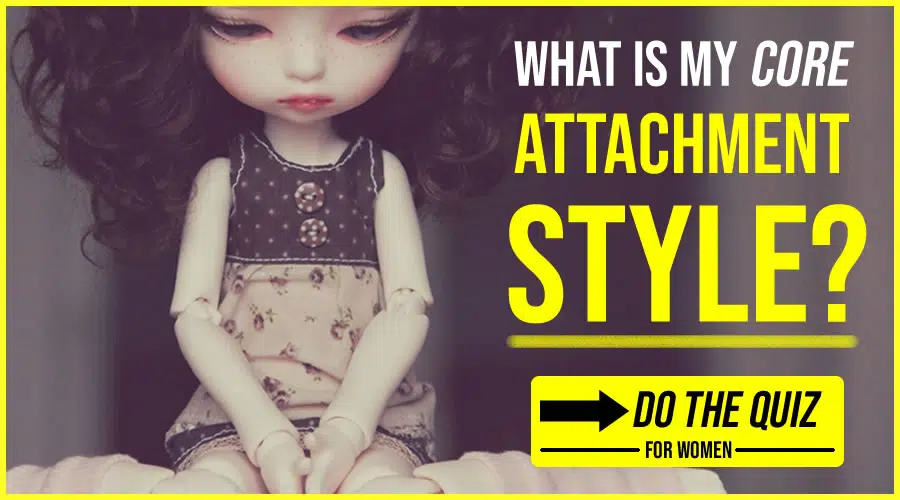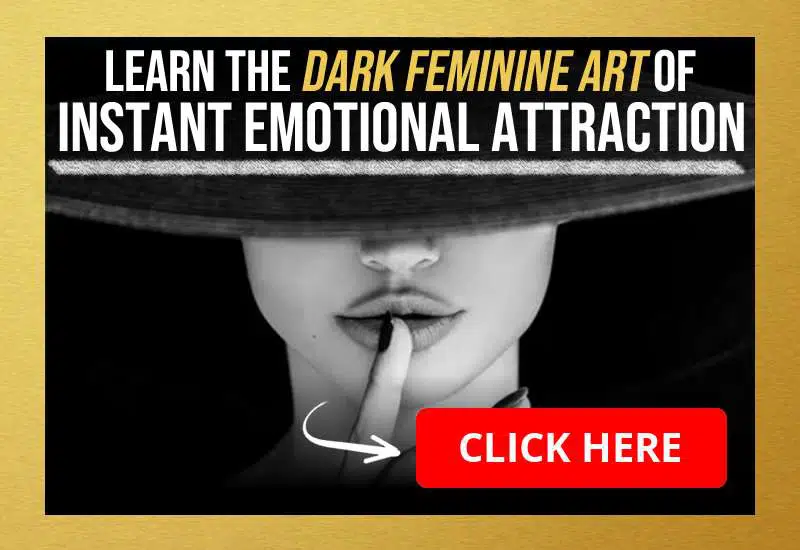Are you in an anxious avoidant relationship and feeling tired of the constant struggle to reach your partner and feel close to your partner?
Are you doing a lot of the chasing, only to come up against your avoidant partner’s walls repeatedly?
Or perhaps you’re struggling with a partner who thinks you have walls up and needs so much more from you, but you have trouble being vulnerable to them.
I understand. The struggle is real, and I’m not here to sugar coat it.
Table of Contents
Why Are Anxious Avoidant Relationships So Hard?
Anxious avoidant relationships are super difficult because you have two people with insecure attachment who cannot fully trust each other.
The anxiously attached person is trying to get attention, reassurance and love from the avoidant partner.
The avoidant partner, if they love the anxious partner, are constantly pulled towards more internal anxiety by the anxious person’s demands, and consequently tends to:
- Become super anxious themselves; and/or
- Shut off and ‘check out’ completely
This of course affirms all of the anxious person’s insecurities, and triggers their deepest fear – the fear of abandonment.
MORE: 15 Signs Of Abandonment Issues & How To Test For Them.
This all sounds like a recipe for disaster, right? What good things could possibly come out of such a toxic cycle?
Well, though this is definitely toxic, there is hope for such a relationship. But how much hope?
That depends on the people in the relationship.
Honestly, most people cannot shoulder the hard, self revealing and vulnerable work that comes with the territory of making an anxious avoidant relationship work.
But I assure you that some people can eventually make it work – with the right mindset.
Because remember, just because you have an avoidant attachment style, doesn’t mean that you cannot open up over time and melt your walls away.
And just because you have anxious attachment, doesn’t mean you cannot learn to soothe your anxiety and show up in a more calibrated way.
Anxious Avoidant Relationships Cannot Be Fixed Before THIS Happens…
Here’s something important that you need to know first:
An anxious avoidant relationship cannot be (properly) fixed unless one or both of you begin to fix your own insecure attachment styles first. (And we have a quiz that will help you with that…)
(Why is this important? It is because your core attachment style largely dictates and influences what happens in your relationship. Thus it’s imperative you understand your core attachment style!)
You may have heard that in order to fix an anxious avoidant relationship, the anxious partner needs to lean back and give space, while the avoidant partner must lean forward to do the work of moving inward to connect.
Whilst this has some surface theoretical truth to it, it’s not actually possible until one or both of you heal your own insecure attachment first.
Why?
For 3 reasons:
- Because you’re asking both people to suddenly do the opposite of what their neurology has been trained to do
- Because by asking an anxiously attached person to give more space or stop chasing, you’re only going to inspire more avoidant behaviors; and
- By asking an avoidant to lean forward into connection, you’re only going to inspire more anxious attachment behaviours.
So in effect if you take that advice, it’s not only going to cause you to take many steps backwards, you’re just going to switch roles:
- Whoever was the anxious person will show up more avoidant; and
- Whoever was the avoidant person will just show up more anxious
At least for a time, until you both return to your natural equilibrium (ie: your natural attachment style).

Attachment Patterns Aren’t Just A “Preference”
If you find yourself doubting that what I’m saying is true, remember that attachment patterns aren’t just about having attachment preferences as the term “attachment styles” would suggest.
It’s actually a pattern that is wired into the person’s neurology.
So the person with anxious attachment has anxiety as their equilibrium, at least until they get tired and become avoidant for a bit.
As I’ve said before, the anxiously attached person is likely also avoidant some of the time, because you cannot sustain anxiety for an extended period of time.
Whilst the avoidant person has detachment coded into their neurology, and if they try to connect, (which is in fact a crucial part of their healing), they will first have to go through the stage of anxiousness.
People with an avoidant attachment style have deactivated their internal attachment needs to avoid deep and recurring painful emotions like unworthiness, anger and shame.
Conversely, anxiously attached people have hyperactivated their attachment seeking (ie: neediness) in order to secure the proximity and responsiveness of caregivers.
(In the case of adults with anxious attachment, obviously this translates to clinginess, neediness, and hyper alertness towards possible threats).
So:
Am I saying it’s impossible to fix an anxious avoidant relationship?
No.
I’m saying it’s going to be a long and rocky road with many setbacks and many moments of tiredness and hopelessness.
But in the moments where you have breakthroughs, it will be wonderful!
I also will say that it will be much easier if you or your partner develop a secure attachment style first.
And it would be infinitely easier if one of you found a secure partner instead, because securely attached people are more resilient and have a nervous system that is much better geared for the job of actually fixing an anxious avoidant relationship.
But I get that that’s not the answer you’re looking for, because you obviously love your partner and want to stay with them.
So I’m going to give you 7 steps to fix the anxious avoidant relationship – also called the anxious avoidant trap.
How To Fix The Anxious Avoidant Relationship? 7 Steps
Step #1: First Confirm Your Attachment Style
First things first: confirm what your attachment style is. Many people work from incorrect labels, but if you’re absolutely sure that you are an anxiously attached person, or that your partner has an avoidant attachment style, that’s good.
But if there’s any doubt in your mind, confirm it first.
You can take our quiz on which is my CORE attachment style?
Or you can read this article on The 4 Types Of Attachment Styles & Which One Are You?
Step #2: If You Have An Anxious Attachment Style, Do This
If you’re the anxiously attached person, then the first thing you need to do is focus on finding a reliable source of certainty that you can go to in times of high anxiety.
I’ve talked before about finding anchors of secure attachment in my article “How To Self Soothe Anxious Attachment In 2 Easy Steps”.
You can find anchors of secure attachment too, or you can find another source of certainty in times of anxiety and conflict.
Anchors of secure attachment are “anchors” such as a song, a movie scene, a mantra or a meditation track that you go to when your anxiety shows up. Alternatively, to calm yourself and to seek certainty through the anxiety storm, you could:
- Find a memory of love and connectedness that you can repeatedly go to in order to bring up feelings of safety and connectedness
- This could involve a memory of a distant family member or friend comforting you, telling you how wonderful you are, telling you that everything is ok, etc
- Focus on connecting to your deeper emotions so that you can grieve and feel connected to something
- Find a safe place to go to breathe deeply and relax yourself
- I also recommend developing a high value mindset, and we have a whole home study course on this.
(The promise of this program is to give you the ability to “trade in” your anxiety and insecurities for self esteem, self worth and intrinsic confidence, so that no one will ever take you for granted & high value men will recognise you as an indispensable “keeper”.) CLICK to find out more about High Value Mindsets. - Use some affirmations for anxious attachment (below)
Step #3: If You Have An Avoidant Attachment Style, Do This
If you’re the person who is avoidant, then your pattern is primarily looking for an escape from any emotion to safety. But usually, for avoidants, their typical escape isn’t real safety.
Their escape is simply detachment – which is not what we’re looking for when answering how to make an anxious avoidant relationship work.
So, instead of having your escape be a literal escape from your partner, here’s your task:
Gradually become a little more vulnerable in your own time. Here’s how:
Uncover some old memories of what it was like growing up, and slowly allow difficult emotions like anger and longing for connection to surface.
And when you can feel them surface, your task is to feel them for as long as possible at the same time as letting yourself know that you’re worthy.
Because avoidants don’t want to feel (be vulnerable), lest they have to feel the deep pain of rejection and unworthiness.
So:
Essentially your job is to first not reject yourself when you’re vulnerable. In private.
To accomplish this, you can also use affirmations for avoidant attachment, in order to build an association of strong self worth in the midst of feeling emotions.
Similar to those with an anxious attachment style, I recommend developing a high value mindset in order to regulate your internal anxiety and fear.
We show you exactly how to do this step by step in our home study course, “High Value Mindsets”.
(The promise of this program is to give you the ability to “trade in” your anxiety and insecurities for self esteem, self worth and intrinsic confidence, so that no one will ever take you for granted & high value men will recognise you as an indispensable “keeper”.)
Step #4: Report To Your Partner Every Few Days About The Work You Have Done
The purpose of this task is to have something in common that you’re willing to work towards together, so that there is something to connect over and you have something in common.
With the anxious avoidant trap, both partners can end up distracted by the many fights, arguments and disconnects caused by their internal attachment models.
You want something that can counter that – a healthy replacement. So long as you don’t resort to accusations, blaming or judging about what the other has or hasn’t done in step 2 and 3.
This step is here so that both partners can begin to make each other feel safe whilst also finding something in common to work towards.
Step #5: Write A Letter To Each Other
Why a letter?
Since both the anxious and the avoidant person are not very good at holding space for other people, and holding space is necessary for having a healthy relationship, writing a letter allows each of you to detail the:
- Memories
- Experiences
- Emotions; and
- Realisations
That you have uncovered in steps 2 and 3. In your letter, you must preface what you’re going to write with:
“I just want to share….”
And
“None of what I’m going to say is your fault, I just need you to know and hear…”
And then you can write about:
- Painful childhood experiences
- Emotions that surface
- Things that scare you
- Things you’re working towards
Hopes and dreams that you have - Anything you need to heal
All simply for the sake of being heard or “read” by your partner.

Step #6: Do Something Novel & Fun Together
So this may seem out of place in a serious article about how to make an anxious avoidant relationship work.
But there’s a reason this step is here, and that’s because you want to form a connection with your partner through more than just one avenue and/or level.
MORE: How to Build Emotional Connection With A Man? Game Changer.
In the previous steps, you connected with each other on some pretty deep and perhaps even dark stuff.
Now, you want to do something novel and fun together to build emotional attraction and emotional connection on a different level.
It helps you guys stay in love and make something just about the two of you, instead of making it about healing past pains and wounds.
So here are some suggestions:
- Go to a fun theme park together
- Take a hike together
- Learn to ballroom dance together
- Go rockclimbing together
- Go paintballing
- Travel to a unique holiday destination

Step #7: Repeat Steps 2- 6
Pretty simple right? Repeat the cycle, and keep committing to doing this together, for each other, to fight for your relationship and you love together.
Those are the 7 steps to fix the anxious avoidant relationship.
Want to Know The Truth About The Anxious Avoidant Trap?
The truth about the anxious avoidant relationship is that it’s hard to fix.
In such a relationship, one or both of you will naturally be triggered.
When the avoidant partner shuts off due to feeling too vulnerable, the anxious person will get triggered, trying earnestly to address the new perceived threat to their sense of security.
It’s not easy for the anxious person to manage their stress, and it’s not easy for the avoidant person to be vulnerable.
So Should You Try To Fix The Anxious Avoidant Relationship?
You should try to fix it if you genuinely love your partner and know deep down inside that you’re meant to be together.
The truth is that the toxicity of the relationship is often too big a cost on both partners.
But if you and your partner love each other very much, then I’d say it’s worth the commitment and it’s worth the effort.
Just don’t expect huge changes overnight.
Instead, ingrain this pattern of steps 1-7 into your life and over time, the anxious person will begin to feel closer and more secure while the avoidant person will feel more comfortable with being close.
Now let’s answer some common questions about the anxious avoidant relationship (or the anxious avoidant trap).
Frequently Asked Questions on The Anxious Avoidant Relationship
How Do You Cure An Anxious Avoidant Relationship?
You cure it by healing or “curing” each partner’s individual attachment style first.
The avoidant will need to gradually earn secure attachment through becoming more vulnerable slowly over time, hopefully with support from the anxious partner.
The anxious partner will need to try to calm their nervous system and alleviate their fears over time through adopting anchors for secure attachment and through affirmations for anxious attachment.
Once each of the people in the relationship heal their own attachment style first, they can then build more secure connection and attachment within their relationship overall.

Can An Anxious Avoidant Relationship Ever Work?
It can work, but not without a lot of conscious effort on the part of both partners.
This will not be easy, and most people aren’t truly ready for the self reflection required and the huge effort involved.
Everyone has their equilibrium when it comes to intimacy, and both the anxious and avoidant partner’s equilibrium are not conducive to a healthy, secure relationship.
Can An Anxious Avoidant Relationship Last?
It can “last”, but often at a huge cost to both partners.
Most partners in this type of relationship tend to make things worse for each other, so even if it does last decades, it will go nowhere healthy or great.
A much better goal than having an anxious avoidant relationship “last”, is for both partners to gradually earn secure attachment, so that they can both bring more emotional resources back to the relationship.
Do Anxious Avoidants Regret Breaking Up?
Of course they do. But often the pain of their regret is not greater than the pain and effort it would require for them to actually be vulnerable in the relationship.
That’s all the frequently asked questions answered! So now over to you!
Do you have any questions or thoughts to share? Feel free to leave them in the comments below!

P.S. CLICK HERE to check out my full article archives! Or you may greatly benefit from one of our highly popular paid programs, CLICK HERE to see what we offer right now.
If you want to be supported by a warm community of high value feminine women, then join our Facebook Group. (It’s free and so incredibly valuable!) CLICK HERE TO join thousands of other women in our “High Value Feminine Women” Community.
By the way, while you’re at it, connect with me on social media.
- Here’s my Youtube Channel The Feminine Woman.
- Here’s The Feminine Woman Facebook page…
- Here’s my Instagram Pages TheFeminineWoman & My Personal Instagram.
P.S. CLICK HERE to check out my full article archives! Or you may greatly benefit from one of our highly popular paid programs, CLICK HERE to see what we offer right now.
If you want to be supported by a warm community of high value feminine women, then join our Facebook Group. (It’s free and so incredibly valuable!) CLICK HERE TO join thousands of other women in our “High Value Feminine Women” Community.
By the way, while you’re at it, connect with me on social media.
- Here’s my Youtube Channel The Feminine Woman.
- Here’s The Feminine Woman Facebook page…
- Here’s my Instagram Pages TheFeminineWoman & My Personal Instagram.

Renee is the founder of The Feminine Woman & co-founder of Shen Wade Media where we teach women how to show up as a high value high status woman whom easily inspires a deep sense of emotional commitment from her chosen man. Together with her husband D. Shen at Commitment Triggers blog, they have positively influenced the lives of over 15 million women through their free articles and videos as well as 10’s of thousands through paid programs through the Shen Wade Media platform.
Connect deeper with her work through the social media links below.


